Effects of Crystal Orientation on the Crack Propagation of Sapphire by Sequential Indentation Testing
Abstract
:1. Introduction
2. Experimental Procedures
3. Results and Discussion
3.1. Nanoindentation Results
3.2. Force Signal Analysis
3.3. Analysis of Indentation Fracture Morphology
3.4. Three-Dimensional Morphology Analysis
3.5. Subsurface Damage Analysis by TEM
4. Conclusions
- The rate of crack propagation on A-plane sapphire was affected by the depth of indentation, which exhibited an obvious regularity. However, the effect of the depth of indentation on crack propagation was not nearly as uniform for C-plane sapphire.
- Different crack systems were indicated for A-plane and C-plane sapphire. Four different crack systems were exhibited by A-plane sapphire. The fracture toughness values of A-plane and C-plane sapphire that were obtained here were smaller than those obtained in previous studies.
- The pile-up of material was observed around the indentations on the A-plane and C-plane faces. For A-plane sapphire, the area of pile-up occurred along the c-axis due to the mechanical anisotropy of sapphire.
- Cross-sectional TEM shows that the domination deformation in the sapphire of A-plane and C-plane was both non-basal dislocation and basal twin.
Acknowledgments
Author Contributions
Conflicts of Interest
References
- Júnior, A.F. Controlled wet erosive wear of sapphire. J. Eur. Ceram. Soc. 2005, 25, 3265–3268. [Google Scholar] [CrossRef]
- Mao, W.G.; Shen, Y.G.; Lu, C. Nanoscale elastic–plastic deformation and stress distributions of the c plane of sapphire single crystal during nanoindentation. J. Eur. Ceram. Soc. 2011, 31, 1865–1871. [Google Scholar] [CrossRef]
- Dobrovinskaya, E.R.; Lytvynov, L.A.; Pishchik, V. Sapphire Material, Manufacturing, Applications; Springer Science+Business Media: New York, NY, USA, 2009; pp. 106–187. ISBN 978-0-387-85695-7. [Google Scholar]
- Graça, S.S.; Trabadelo, V.; Neels, A.; Kuebler, J.; Nader, V.L.; Gamez, G.; Döbeli, M.; Wasmer, K. Influence of mosaicity on the fracture behavior of sapphire. Acta Mater. 2014, 67, 67–80. [Google Scholar] [CrossRef]
- Armstrong, R.W.; Walley, S.M.; Elban, W.L. Crystal Indentation Hardness. Crystals 2017, 7, 21. [Google Scholar] [CrossRef]
- Galanov, B.A.; Milman, Y.V.; Chugunova, S.I.; Goncharova, I.V.; Voskoboinik, I.V. Application of the Improved Inclusion Core Model of the Indentation Process for the Determination of Mechanical Properties of Materials. Crystals 2017, 7, 87. [Google Scholar] [CrossRef]
- Ruestes, C.J.; Alhafez, I.A.; Urbassek, H.M. Atomistic Studies of Nanoindentation—A Review of Recent Advances. Crystals 2017, 7, 293. [Google Scholar] [CrossRef]
- Mao, W.; Shen, Y. Nanoindentation study of pop-in phenomenon characteristics and mechanical properties of sapphire 102 crystal. J. Am. Ceram. Soc. 2012, 95, 3605–3612. [Google Scholar] [CrossRef]
- Bhattacharya, M.; Dey, A.; Mukhopadhyay, A.K. Influence of loading rate on nanohardness of sapphire. Ceram. Int. 2016, 42, 13378–13386. [Google Scholar] [CrossRef]
- Bradby, J.E.; Kucheyev, S.O.; Williams, J.S.; Wongleung, J.; Swain, M.V.; Munroe, P.; Li, G.; Phillips, M.R. Indentation-induced damage in GaN epilayers. Appl. Phys. Lett. 2002, 80, 383–385. [Google Scholar] [CrossRef]
- Nowak, R.; Manninen, T.; Heiskanen, K.; Sekino, T.; Hikasa, A.; Niihara, K.; Takagi, T. Peculiar surface deformation of sapphire Numerical simulation of nanoindentation. Appl. Phys. Lett. 2003, 83, 5214–5216. [Google Scholar] [CrossRef]
- Huang, J.; Xu, K.; Gong, X.J.; Wang, J.F.; Fan, Y.M.; Liu, J.Q.; Zeng, X.H.; Ren, G.Q.; Zhou, T.F.; Yang, H. Dislocation cross-slip in GaN single crystals under nanoindentation. Appl. Phys. Lett. 2011, 98, 221906:1–221906:3. [Google Scholar] [CrossRef]
- Zhang, Y.; Zhang, L.; Liu, M.; Zhang, F.; Mylvaganam, K.; Liu, W. Understanding the friction and wear of KDP crystals by nanoscratching. Wear 2015, 332–333, 900–906. [Google Scholar] [CrossRef]
- Nowak, R.; Sekino, T.; Maruno, S.; Niihara, K. Deformation of sapphire induced by a spherical indentation on the 100 plane. Appl. Phys. Lett. 1996, 68, 1063–1065. [Google Scholar] [CrossRef]
- Guillou, M.O.; Henshall, J.L.; Hooper, R.M. Indentation fracture and soft impresser fatigue in sapphire and polycrystalline alumina. Int. J. Refract. Met. Hard Mater. 1998, 16, 323–329. [Google Scholar] [CrossRef]
- Haney, E.J.; Subhash, G. Static and dynamic indentation response of basal and prism plane sapphire. J. Eur. Ceram. Soc. 2011, 31, 1713–1721. [Google Scholar] [CrossRef]
- Zhang, C.; Feng, P.; Zhang, J. Ultrasonic vibration-assisted scratch-induced characteristics of c-plane sapphire with a spherical indenter. Int. J. Mach. Tools Manuf. 2013, 64, 38–48. [Google Scholar] [CrossRef]
- Haney, E.J.; Subhash, G. Analysis of interacting cracks due to sequential indentations on sapphire. Acta Mater. 2011, 59, 3528–3536. [Google Scholar] [CrossRef]
- Huang, L.; Bonifacio, C.; Song, D.; Benthem, K.V.; Mukherjee, A.K.; Schoenung, J.M. Investigation into the microstructure evolution caused by nanoscratch-induced room temperature deformation in M-plane sapphire. Acta Mater. 2011, 59, 5181–5193. [Google Scholar] [CrossRef]
- Wang, S.; An, C.; Zhang, F.; Wang, J.; Lei, X.; Zhang, J. An experimental and theoretical investigation on the brittle ductile transition and cutting force anisotropy in cutting KDP crystal. Int. J. Mach. Tools Manuf. 2016, 106, 98–108. [Google Scholar] [CrossRef]
- Zong, W.J.; Wu, D.; Li, Z.Q. Strength dependent design method for the crystal orientation of diamond berkovich indenter. Mater. Des. 2015, 89, 1057–1070. [Google Scholar] [CrossRef]
- Li, X.; Li, Z.; Tao, X.F.; Ren, L.L.; Gao, S.T.; Xu, G.F. Distribution of residual strain around nanoindentations in silicon. Mater. Lett. 2014, 132, 285–289. [Google Scholar] [CrossRef]
- Lawn, B.R.; Evans, A.G.; Marshall, D.B. Elastic/plastic indentation damage in ceramics the median/radial crack system. J. Am. Ceram. Soc. 1980, 63, 574–581. [Google Scholar] [CrossRef]
- Kim, Y.G.; Kim, D.K. In situ observation of fracture sequence of physical vapor deposited tin film on 1120 sapphire. J. Mater. Res. 2005, 20, 1389–1395. [Google Scholar] [CrossRef]
- Anstis, G.R.; Chantikul, P.; Lawn, B.R.; Marshall, D.B. A critical evaluation of indentation techniques for measuring fracture toughness i, direct crack measurements. J. Am. Ceram. Soc. 1981, 64, 533–538. [Google Scholar] [CrossRef]
- Newcomb, S.A.; Tressler, R.E. High-temperature fracture toughness of sapphire. J. Am. Ceram. Sci. 1994, 77, 3030–3032. [Google Scholar] [CrossRef]
- Wunderlich, W.; Awaji, H. Molecular dynamics-simulations of the fracture toughness of sapphire. Prog. Theor. Phys. Suppl. 2001, 22, 53–59. [Google Scholar] [CrossRef]
- Marshall, D.B.; Lawn, B.R. Residual stress effects in sharp contact cracking. J. Mater. Sci. 1979, 14, 2001–2012. [Google Scholar] [CrossRef]
- Tymiak, N.I.; Gerberich, W.W. Initial stages of contact-induced plasticity in sapphire. I. Surface traces of slip and twinning. Philos. Mag. 2007, 87, 5143–5168. [Google Scholar] [CrossRef]
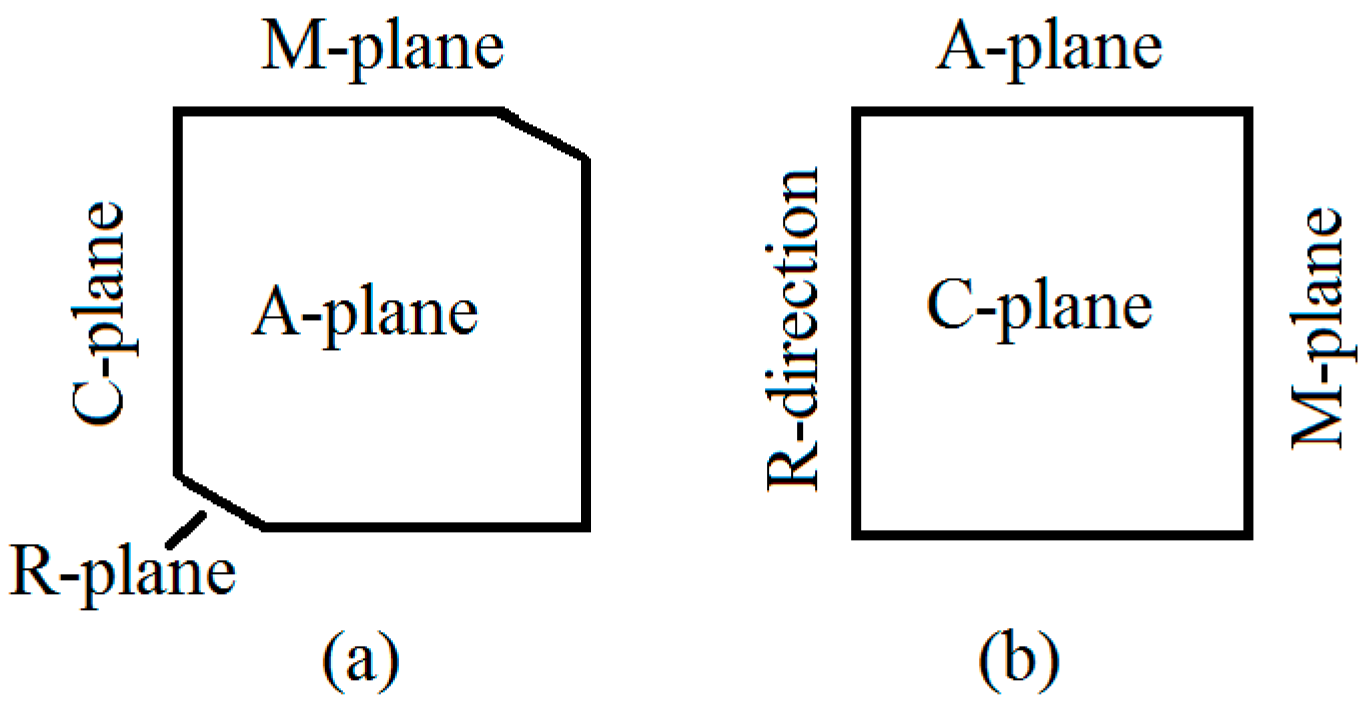
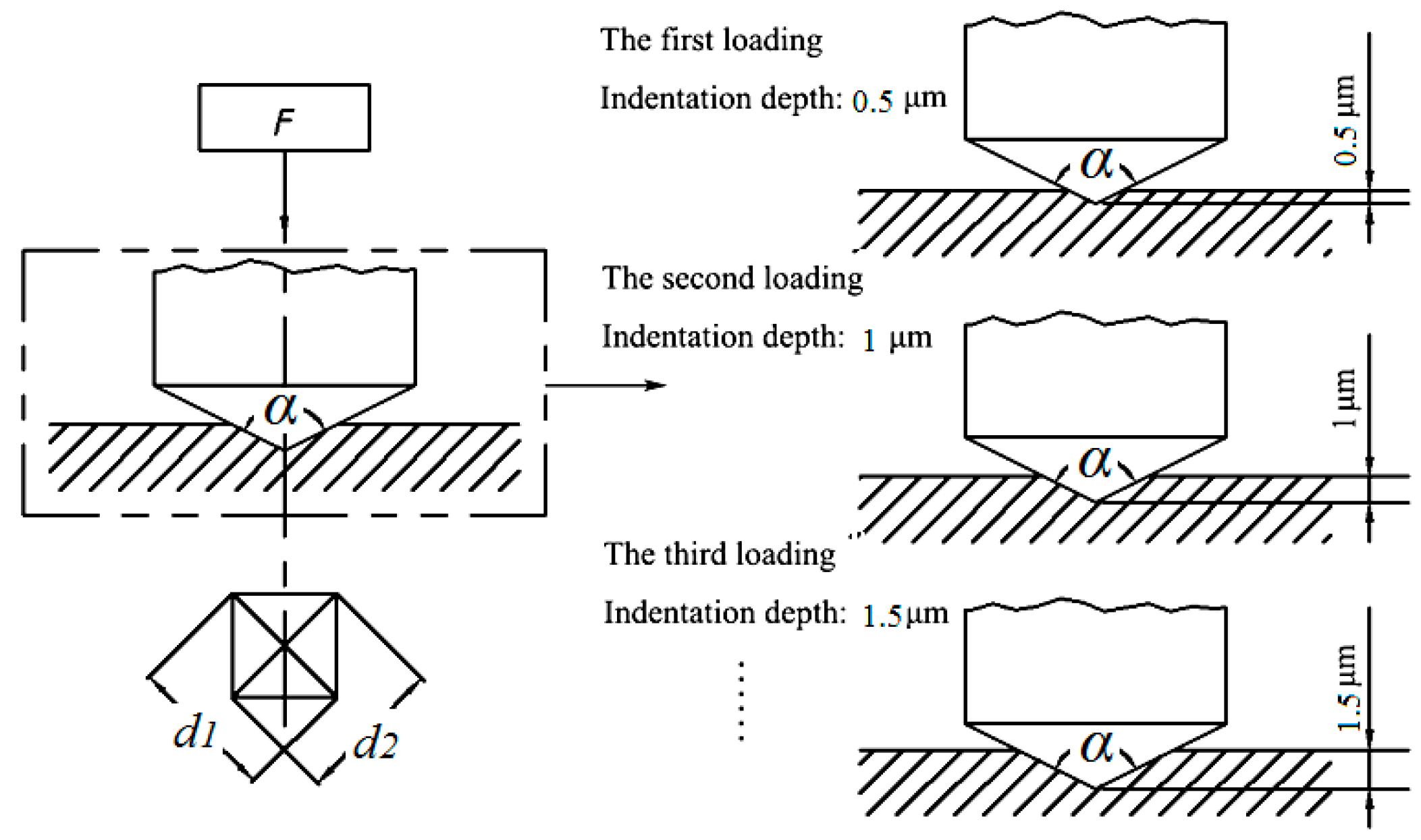
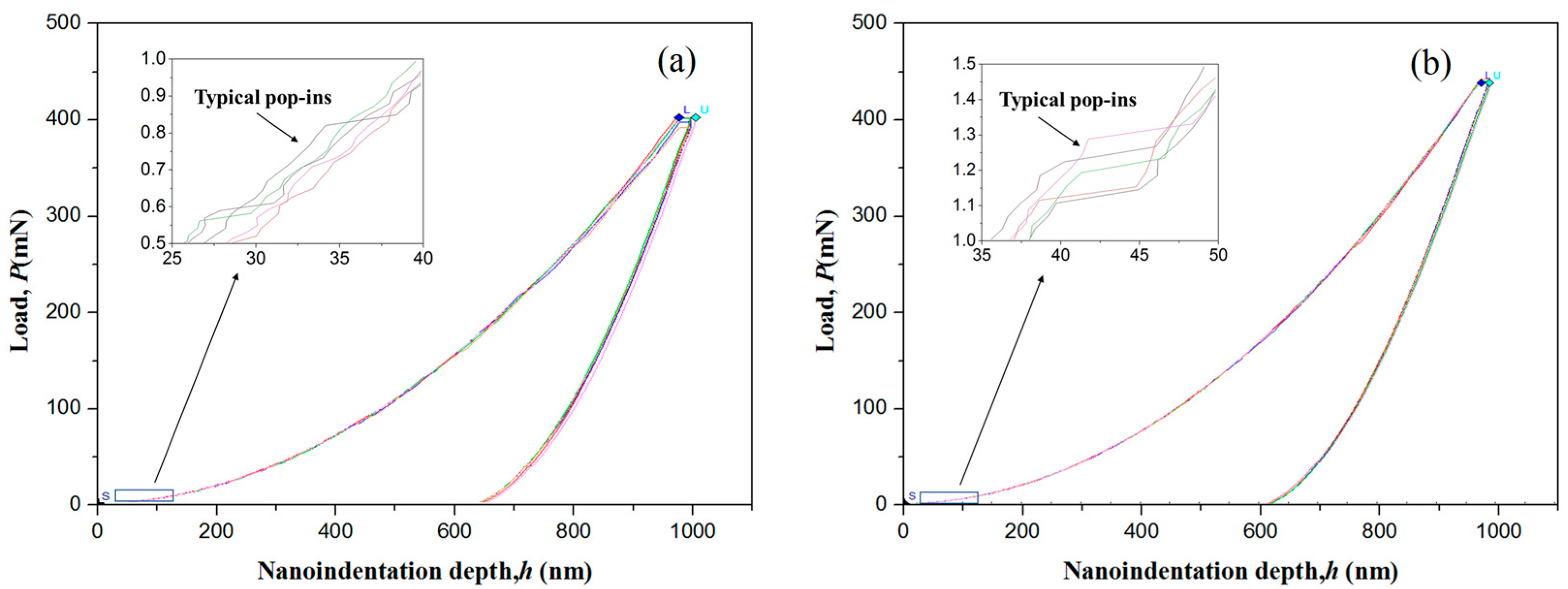
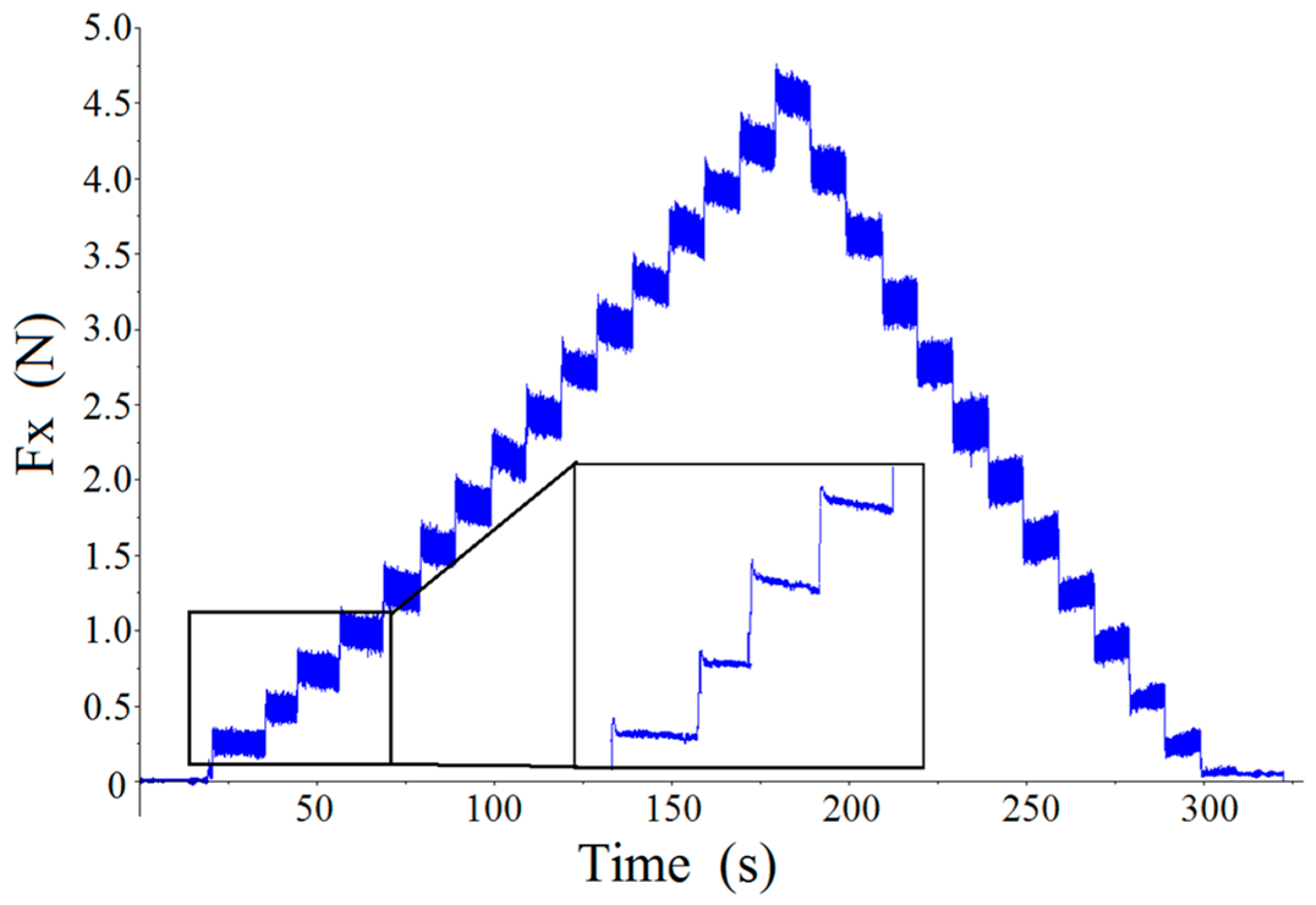
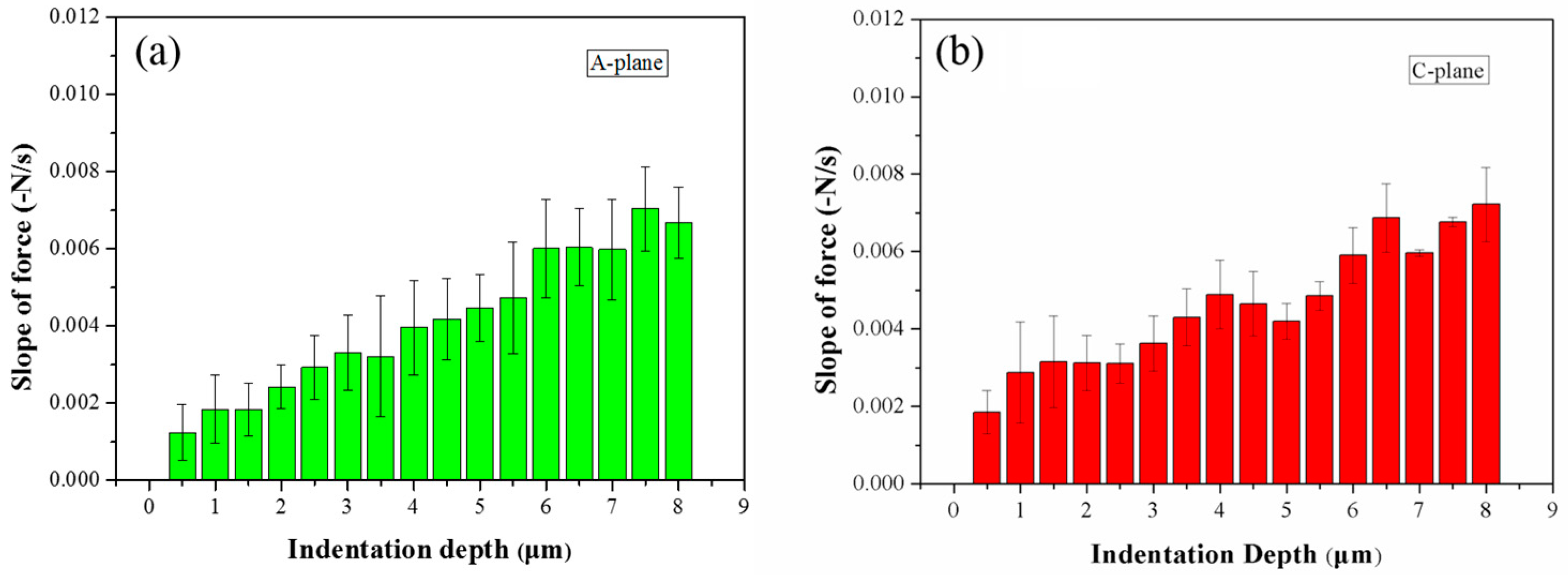
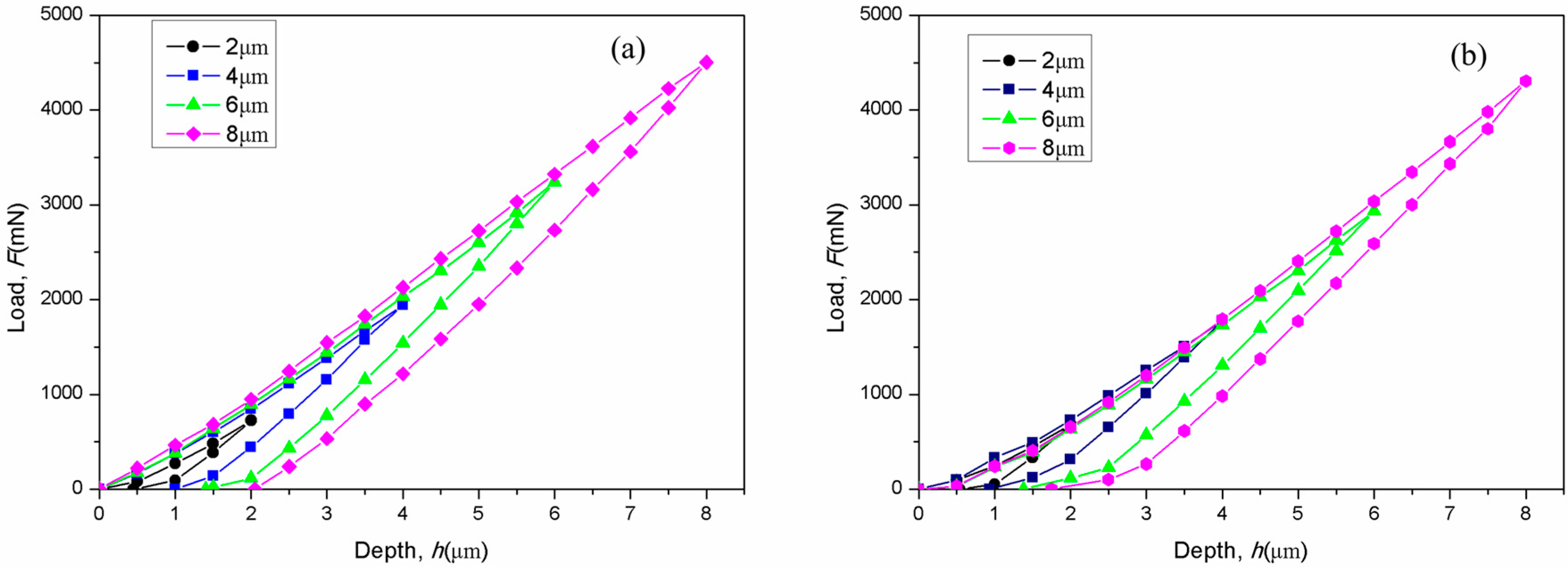

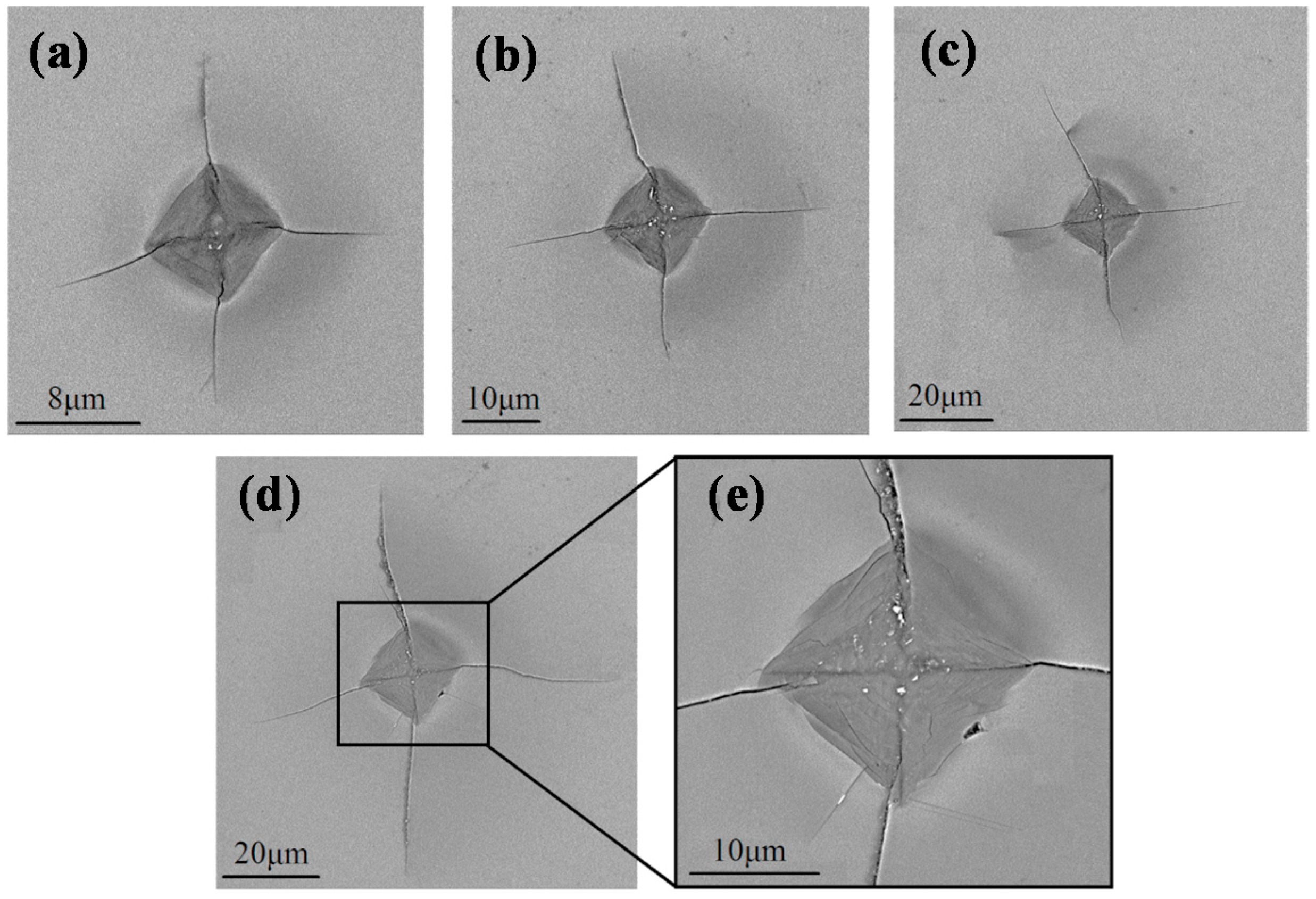
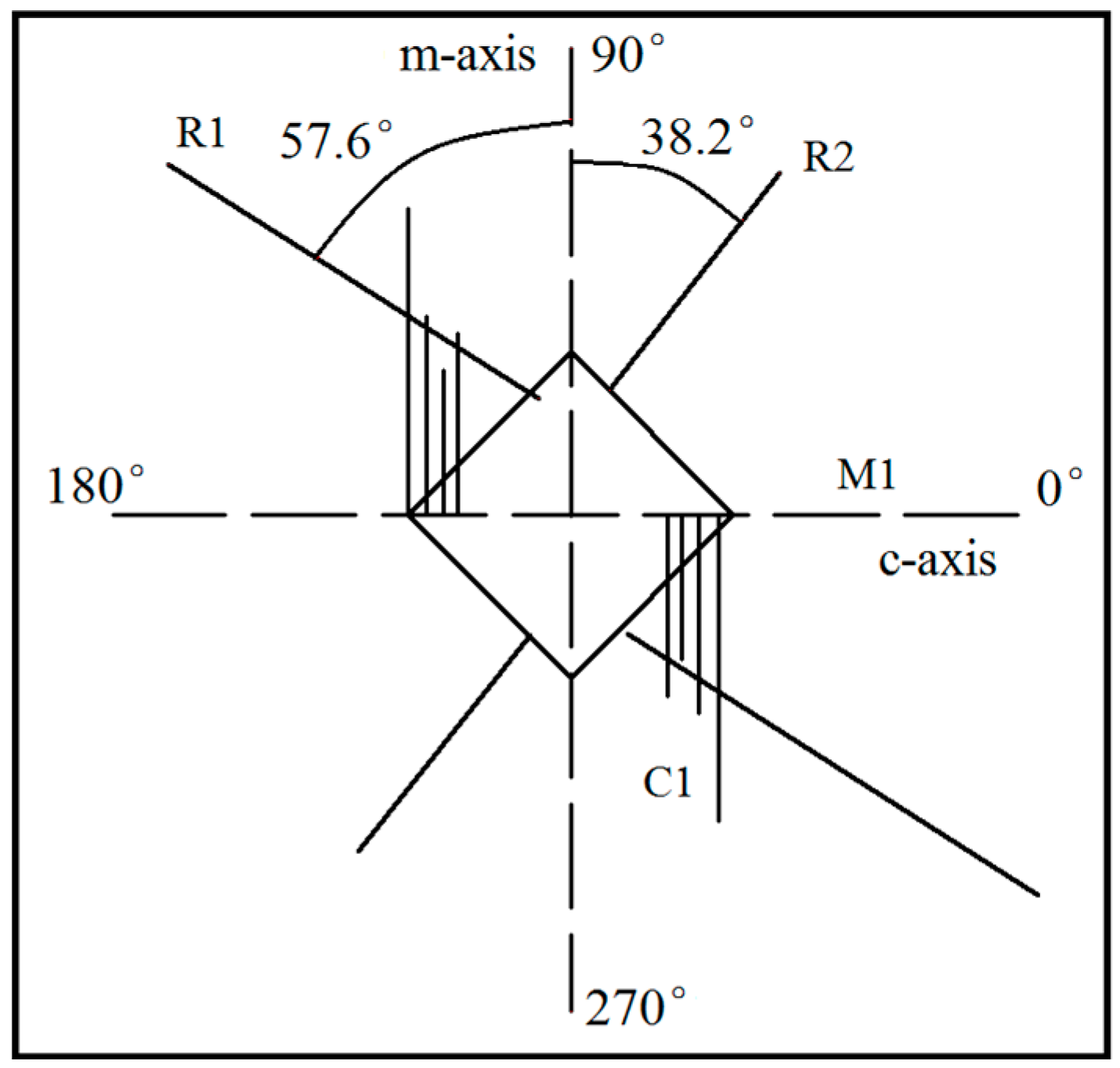
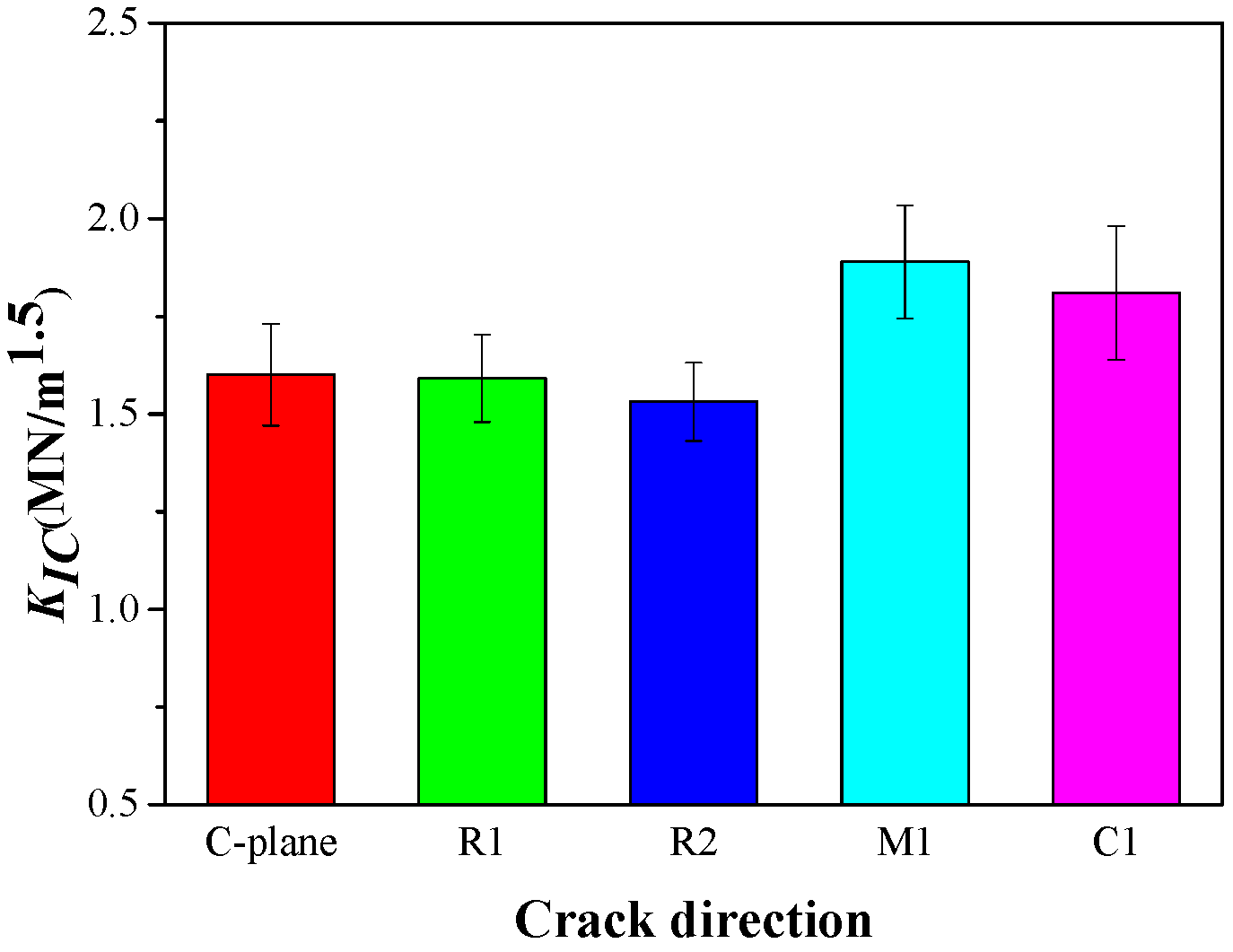
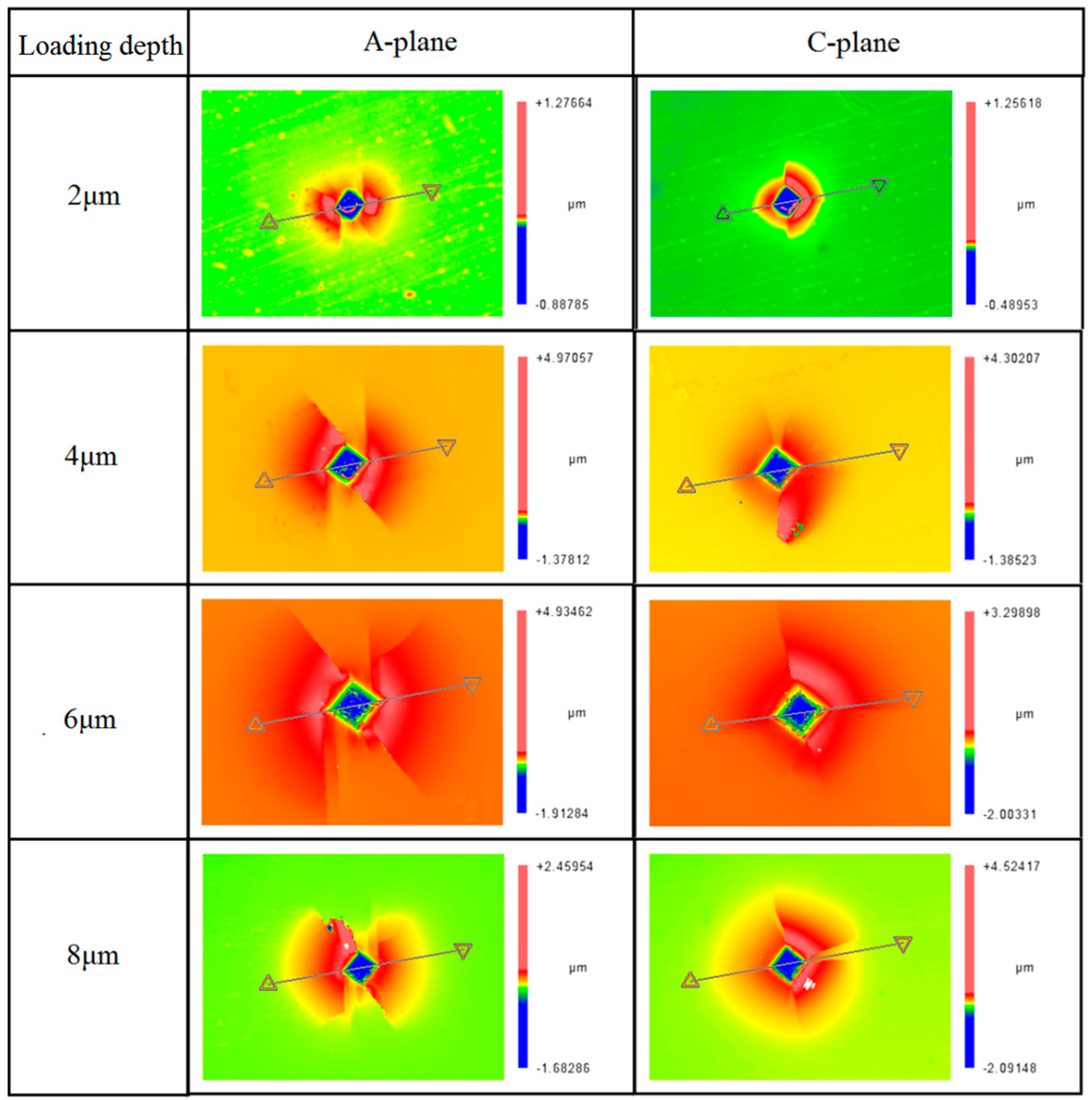


| Conditions | Value |
|---|---|
| Indentation load range | 0–10 N |
| Infeed depth interval | 0.5 μm |
| Dwell period | 10 s |
| Maximum Depths of Indentation | 2 μm, 4 μm, 6 μm and 8 μm |
| Conditions | Value |
|---|---|
| Objective | ×50 |
| Zoom | ×2 |
| Scan length | 5 μm |
| Number of scans in average | 5 |
© 2017 by the authors. Licensee MDPI, Basel, Switzerland. This article is an open access article distributed under the terms and conditions of the Creative Commons Attribution (CC BY) license (http://creativecommons.org/licenses/by/4.0/).
Share and Cite
Wang, N.; Jiang, F.; Xu, X.; Lu, X. Effects of Crystal Orientation on the Crack Propagation of Sapphire by Sequential Indentation Testing. Crystals 2018, 8, 3. https://doi.org/10.3390/cryst8010003
Wang N, Jiang F, Xu X, Lu X. Effects of Crystal Orientation on the Crack Propagation of Sapphire by Sequential Indentation Testing. Crystals. 2018; 8(1):3. https://doi.org/10.3390/cryst8010003
Chicago/Turabian StyleWang, Ningchang, Feng Jiang, Xipeng Xu, and Xizhao Lu. 2018. "Effects of Crystal Orientation on the Crack Propagation of Sapphire by Sequential Indentation Testing" Crystals 8, no. 1: 3. https://doi.org/10.3390/cryst8010003




